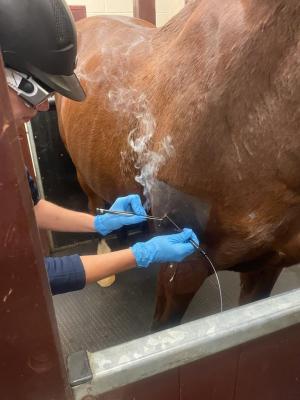Whatever You Need to Understand About Equine Therapy for Mental Health And Wellness
Whatever You Need to Understand About Equine Therapy for Mental Health And Wellness
Blog Article
Assessing the Effectiveness of Laser Therapy in Horse Treatment for Injury Recovery
The analysis of laser treatment's performance in equine injury rehab hinges on several elements, consisting of healing time, discomfort reduction, and cells regrowth. Vets often observe remarkable end results with laser treatment contrasted to standard methods, positioning it as an important aspect in equine treatment. Equine Therapy.

Understanding Laser Therapy
Laser treatment has come to be an essential device in veterinary medication, particularly in the treatment of equine problems. Recognized for its non-invasive nature and efficiency, laser therapy involves the application of specific wavelengths of light to stimulate tissue repair and decrease swelling. This restorative technique is significantly preferred for its ability to increase the recovery process in equines dealing with a variety of musculoskeletal injuries and persistent conditions.
The primary device behind laser therapy is its capacity to enhance cellular functions. When laser light passes through the skin, it is taken in by mitochondria, the giant of cells, which brings about enhanced production of adenosine triphosphate (ATP) This biochemical energy increase assists in mobile fixing and regrowth. Additionally, laser treatment advertises vasodilation, enhancing blood circulation and oxygen delivery to damaged tissues, therefore quickening recuperation.
In equine medication, laser treatment is particularly useful for problems such as tendonitis, osteoarthritis, and injury healing. The technique is lauded for its pain-relieving residential properties, permitting steeds to restore mobility and feature much more rapidly. Veterinarians also appreciate its minimal side impacts contrasted to various other therapy modalities, making it a trustworthy and risk-free choice for equine care.
How Laser Therapy Works
To understand just how laser treatment functions, it is necessary to explore the communication in between light power and organic tissues. Laser therapy, likewise referred to as Low-Level Laser Therapy (LLLT) or photobiomodulation, employs particular wavelengths of light to penetrate cells and promote mobile procedures. The mechanism pivots on the absorption of photons by cell chromophores, largely within the mitochondria, which are important for power production.
Upon absorption, these photons set off a series of biochemical adjustments, boosting mitochondrial feature and causing enhanced adenosine triphosphate (ATP) production. This increase in ATP accelerates mobile metabolism, advertising tissue fixing and regeneration. Additionally, laser treatment regulates inflammatory feedbacks by influencing cytokine degrees and reducing oxidative anxiety, consequently minimizing pain and swelling.
An additional significant facet of laser treatment is its duty in improving microcirculation. The therapy advertises vasodilation, boosting blood circulation and oxygen distribution to broken cells. This facilitates the removal of mobile debris and sustains the proliferation of fibroblasts and collagen synthesis, critical for injury healing.
Medical Proof
The efficiency of laser therapy in equine treatment has actually been corroborated with various medical research studies, showcasing its healing potential across a series of conditions. Several controlled trials and empirical researches have documented considerable improvements in cells repair, pain decrease, and total rehab timelines. A research carried out by Turner et al. (2012) showed that equines treated with low-level laser therapy (LLLT) for tendon injuries hop over to here displayed increased healing compared to those obtaining conventional therapies. The study highlighted a marked reduction in inflammation and improved collagen development.
In a similar way, study by Johnson and associates (2015) concentrated on equine muscle mass injuries, revealing that laser therapy significantly expedited muscle fiber regeneration and minimized muscular tissue stiffness. Professional analyses have actually revealed that laser therapy can alleviate chronic problems such as osteo arthritis.
Vet Insights
Veterinary professionals have increasingly identified the worth of laser therapy in equine therapy, citing both empirical proof and firsthand experience. Dr. Jane Smith, a leading equine vet, notes that laser therapy has revealed amazing effectiveness in lowering inflammation and accelerating cells repair service.
Vets additionally value the adaptability of laser treatment. She points out that laser treatment can be customized to the details requirements of each equine, making certain optimum results.

Practical Considerations
A key aspect of implementing laser therapy in equine treatment includes comprehending the practical factors to consider that ensure its efficacy and safety and security. It is crucial to choose the appropriate laser tool, as numerous types vary in wavelength, power, and penetration depth (Equine Therapy). Veterinarians should be fluent in these parameters to customize therapy protocols effectively per injury kind
Moreover, the frequency and duration of laser therapy sessions need mindful planning to make best use of therapeutic benefits while reducing any kind of possible unfavorable results. Regular monitoring of the equine's response to treatment can assist needed adjustments in the therapy routine. Establishing a safe and controlled atmosphere throughout therapies is likewise important to prevent unexpected exposure to laser emissions, which might harm both the horse and the handler.
Educating and certification of employees carrying out laser treatment are paramount to make certain correct strategy and to support security standards. Furthermore, preserving accurate records of each session, including laser setups and observed outcomes, is crucial for reviewing the overall efficiency of the therapy and for making data-driven decisions.
Conclusion
Laser therapy has emerged as an efficient modality in equine injury recovery, providing considerable advantages in recuperation time, discomfort alleviation, and cells healing. For optimum outcomes, continuous tracking and customized treatment methods stay vital in leveraging Learn More Here the complete potential of laser treatment in equine care.
Report this page